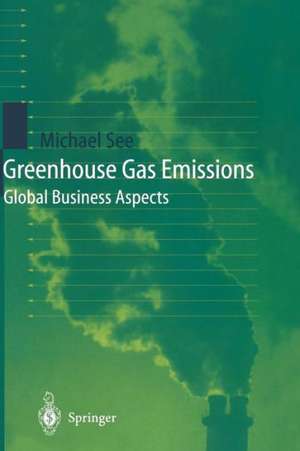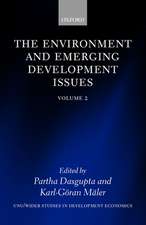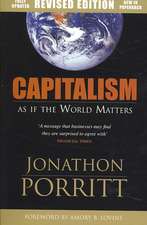Greenhouse Gas Emissions: Global Business Aspects
Autor Michael Seeen Limba Engleză Paperback – 23 oct 2012
| Toate formatele și edițiile | Preț | Express |
|---|---|---|
| Paperback (1) | 645.60 lei 6-8 săpt. | |
| Springer Berlin, Heidelberg – 23 oct 2012 | 645.60 lei 6-8 săpt. | |
| Hardback (1) | 708.44 lei 6-8 săpt. | |
| SPRINGER-VERLAG BERLIN AND HEIDELBERG GMBH & CO. KG – 21 mai 2001 | 708.44 lei 6-8 săpt. |
Preț: 645.60 lei
Preț vechi: 759.54 lei
-15% Nou
Puncte Express: 968
Preț estimativ în valută:
123.54€ • 132.10$ • 103.00£
123.54€ • 132.10$ • 103.00£
Carte tipărită la comandă
Livrare economică 17 aprilie-01 mai
Preluare comenzi: 021 569.72.76
Specificații
ISBN-13: 9783642632273
ISBN-10: 3642632270
Pagini: 404
Ilustrații: XXV, 375 p.
Dimensiuni: 155 x 235 x 21 mm
Greutate: 0.56 kg
Ediția:Softcover reprint of the original 1st ed. 2001
Editura: Springer Berlin, Heidelberg
Colecția Springer
Locul publicării:Berlin, Heidelberg, Germany
ISBN-10: 3642632270
Pagini: 404
Ilustrații: XXV, 375 p.
Dimensiuni: 155 x 235 x 21 mm
Greutate: 0.56 kg
Ediția:Softcover reprint of the original 1st ed. 2001
Editura: Springer Berlin, Heidelberg
Colecția Springer
Locul publicării:Berlin, Heidelberg, Germany
Public țintă
ResearchCuprins
1 Introduction.- 2 Global Warming.- 3 The Kyoto Protocol’s Flexible Mechanisms.- 4 Institutional Issues.- 5 Global Emissions of Carbon Dioxide.- 6 Clean Development Mechanism Project Prospects.- 7 Project Parameters and Equitable Treatment.- 8 CO2 Reduction Technologies and Financial Analysis.- 9 Emissions Trading.- Conclusions.- Appendices.- A1 Contact Addresses of Environmental Authorities/Relevant Government Authorities in Developing Countries.- A2 United Nations and Multilateral Environmental Organisations Concerned with Environmental Policies and Financing of Projects.- A3 Emissions Measurement and Monitoring.- A3.1 Technical Methods (Table A3.1).- A3.2 Maintaining Sustainability in Kyoto Protocol Projects.- A3.3 World Bank Guidelines on Environmental Standards — Major Atmospheric, Land and Water Pollutants from Industries and Domestic Sources (Table A3.2).- A4 The Green 500 Project — A National Green Index to Rank Firms, Case Study: United Kingdom, Case Example 1, Case Example 2 (Tables A4.1, A4.2).- A5 Carbon Accounting and Carbon Taxes.- A5.1 Accounting for Carbon Assets.- A5.2 Effect of Taxation on Carbon Dioxide Emissions.- A6 National Pilot Schemes for Emissions Permits Trading Outside Annex I countries.- A6.1 National Permits Trading Scheme for India and China: Bilateral Cooperation Between the World’s Two Most Populous Countries.- A6.2 Model Questionnaire to Enterprises in Developing Countries.- A7.1 Annuitised and Levelised Costs of Carbon Abatement.- A7.2 Pricing Credits or Permits: Calculating “Overnight” and “Discounted” Cost.- A7.5 Economics of Energy Conversion — Coal to Natural Gas for Power Stations.- A8 Cost Data — Indicative Costs of Key Equipment for Thermal Power Projects.- A9.1 The Clean Development Mechanism.- A9.2 Role ofthe Conference of the Parties (Governments).- A9.3 The Role of the Private Sector and Trading Exchanges.- A9.4 Kyoto Protocol and Non-Kyoto Protocol Risks.- A9.5 Case for Private Sector Financing of CDM Projects.- A9.6 Issues Regarding “Tradability” of Emissions Credits Earned by Non-Annex I Firms.- A9.7 Case of Governments Which Have Not, or May Not, Sign Up to the Kyoto Protocol.- A9.8 Countries Listed in Annex I to the Convention Compared to Countries listed in Annex B to the Protocol.- A9.9 Definition of Small and Medium-Size Enterprises, and Large Companies.- A9.10 Project Selection Criteria for the CDM: Industries and Country Targets.- A9.11 Reference Datum for Measuring Emissions Reductions for CDM: Emissions Additionally.- A9.12 How Annex I Countries Can Move Ahead with the CDM.- A9.13 A Global Private Equity Fund — The World CDM Green Fund.- A10 Islands-at-Risk — Contingency Plans for Evacuation and Resettlement (Tables A10.1, A10.2, A10.3 and A10.4).- Annexes Annex 1 Annex A of the Kyoto Protocol: Targeted Greenhouse Gases and Sources.- Annex 2 Annex B of the Kyoto Protocol: Countries and QELRCs (commitments).- Annex 4 List of Countries Signing and Ratifying the Kyoto Protocol, at end 1999.- Units, Definitions and Conversion Factors.- Figures Index.- Country, Place Index.- Persons Index.
Recenzii
From the reviews of the first edition:
"This book principally addresses climate change and describes remedial strategies for developing countries based on the ‘Clean development mechanism’ of the ‘Kyoto Protocol’. It provides a very comprehensive account of the array of proposals and economic instruments devised by the international community - including the Joint Implementation and Emissions Training initiatives of the Protocol - to abate global warming. The effects of other major atmospheric, land and water pollutants from industries and domestic sources are also covered." (Bulletin of the International Institute of Refrigeration, Issue 3, 2002)
"This book principally addresses climate change and describes remedial strategies for developing countries based on the ‘Clean development mechanism’ of the ‘Kyoto Protocol’. It provides a very comprehensive account of the array of proposals and economic instruments devised by the international community - including the Joint Implementation and Emissions Training initiatives of the Protocol - to abate global warming. The effects of other major atmospheric, land and water pollutants from industries and domestic sources are also covered." (Bulletin of the International Institute of Refrigeration, Issue 3, 2002)
Caracteristici
Very new proposals on the practical implementation and financing of remedial strategies for developing countries based on the Clean Development Mechanism of the Kyoto Protocol. Includes supplementary material: sn.pub/extras
















